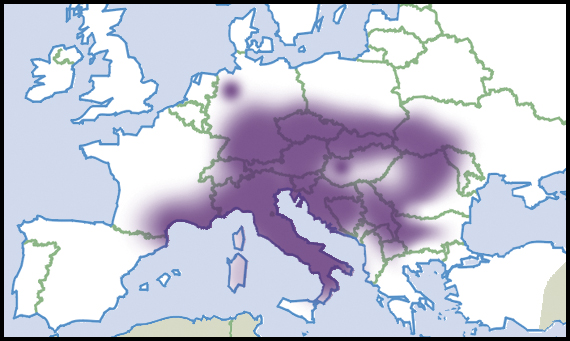Vitrea Diaphana on:
[Wikipedia]
[Google]
[Amazon]
''Vitrea diaphana'' is a
 The distribution of this species is alpine and southern-European. Lisický M. J. (1991)
The distribution of this species is alpine and southern-European. Lisický M. J. (1991)
''Mollusca Slovenska''
he Slovak molluscs VEDA vydavateľstvo Slovenskej akadémie vied, Bratislava, 344 pp. *
Held, F. (1837-1838). Notizen über die Weichthiere Bayerns. Isis (Oken), 30 (4): 303-309 (1837); 30 (12): 901-919 (1838). Leipzig
{{Taxonbar, from=Q14753931 Pristilomatidae Gastropods described in 1820
species
A species () is often defined as the largest group of organisms in which any two individuals of the appropriate sexes or mating types can produce fertile offspring, typically by sexual reproduction. It is the basic unit of Taxonomy (biology), ...
of small, air-breathing land snail
A land snail is any of the numerous species of snail that live on land, as opposed to the sea snails and freshwater snails. ''Land snail'' is the common name for terrestrial molluscs, terrestrial gastropod mollusks that have gastropod shell, shel ...
, a terrestrial pulmonate
Pulmonata or pulmonates is an informal group (previously an order, and before that, a subclass) of snails and slugs characterized by the ability to breathe air, by virtue of having a pallial lung instead of a gill, or gills. The group inclu ...
gastropod
Gastropods (), commonly known as slugs and snails, belong to a large Taxonomy (biology), taxonomic class of invertebrates within the phylum Mollusca called Gastropoda ().
This class comprises snails and slugs from saltwater, freshwater, and fro ...
mollusk
Mollusca is a phylum of protostomic invertebrate animals, whose members are known as molluscs or mollusks (). Around 76,000 extant species of molluscs are recognized, making it the second-largest animal phylum after Arthropoda. The ...
in the family Pristilomatidae.MolluscaBase eds. (2023). MolluscaBase. Vitrea diaphana (S. Studer, 1820). Accessed through: World Register of Marine Species at: https://www.marinespecies.org/aphia.php?p=taxdetails&id=875637 on 2023-06-14
This is the type species
In International_Code_of_Zoological_Nomenclature, zoological nomenclature, a type species (''species typica'') is the species name with which the name of a genus or subgenus is considered to be permanently taxonomically associated, i.e., the spe ...
of the genus '' Vitrea''.
Description
The coiled, rather small, dextral shell is very flattened and conical, the seam hardly rises when viewed from the side. It has a width of 3.1 to 4.2 mm and a height of 1.8 to 2.1 mm. It contains 5½ to 6 tightly wound, regular, only slowly increasing whorls. The body whorl is 1.7 to 2.3 times as wide at the aperture as the penultimate. The aperture is almost half cut off from the penultimate. It is transversely elliptic or transversely ovate when viewed directly from above, and has an obliquely crescent shape, due to the strong incision made by the previous whorl. The aperture is almost perpendicular to the shell axis. The edge of the aperture is usually straight and tapers into a point. However, it can be slightly amplified every now and then. The columella is folded and callused. The umbilicus is closed and often covered by the folded edge of the columella. The thin shell is colorless and glassy translucent. The surface is almost smooth and has a high gloss. The growth lines are only clearly visible near the seam and are slightly more striped.Distribution
 The distribution of this species is alpine and southern-European. Lisický M. J. (1991)
The distribution of this species is alpine and southern-European. Lisický M. J. (1991)''Mollusca Slovenska''
he Slovak molluscs VEDA vydavateľstvo Slovenskej akadémie vied, Bratislava, 344 pp. *
Czech Republic
The Czech Republic, also known as Czechia, and historically known as Bohemia, is a landlocked country in Central Europe. The country is bordered by Austria to the south, Germany to the west, Poland to the northeast, and Slovakia to the south ...
* Ukraine
Ukraine is a country in Eastern Europe. It is the List of European countries by area, second-largest country in Europe after Russia, which Russia–Ukraine border, borders it to the east and northeast. Ukraine also borders Belarus to the nor ...
Balashov I. & Gural-Sverlova N. (2012). "An annotated checklist of the terrestrial molluscs of Ukraine". ''Journal of Conchology'' 41(1): 91-109.
''Vitrea diaphana'' lives in moderately moist locations, under leaf litter and dead wood, among rocks and debris of mountain forests.
References
*Pintér, L. (1972). Die Gattung Vitrea Fitzinger, 1833 in den Balkanländern (Gastropoda: Zonitidae). Annales Zoologici, 29 (8): 209–315. Warszawa * Sysoev, A. V. & Schileyko, A. A. (2009). Land snails and slugs of Russia and adjacent countries. Sofia/Moskva (Pensoft). 312 pp., 142 plates.External links
Held, F. (1837-1838). Notizen über die Weichthiere Bayerns. Isis (Oken), 30 (4): 303-309 (1837); 30 (12): 901-919 (1838). Leipzig
{{Taxonbar, from=Q14753931 Pristilomatidae Gastropods described in 1820